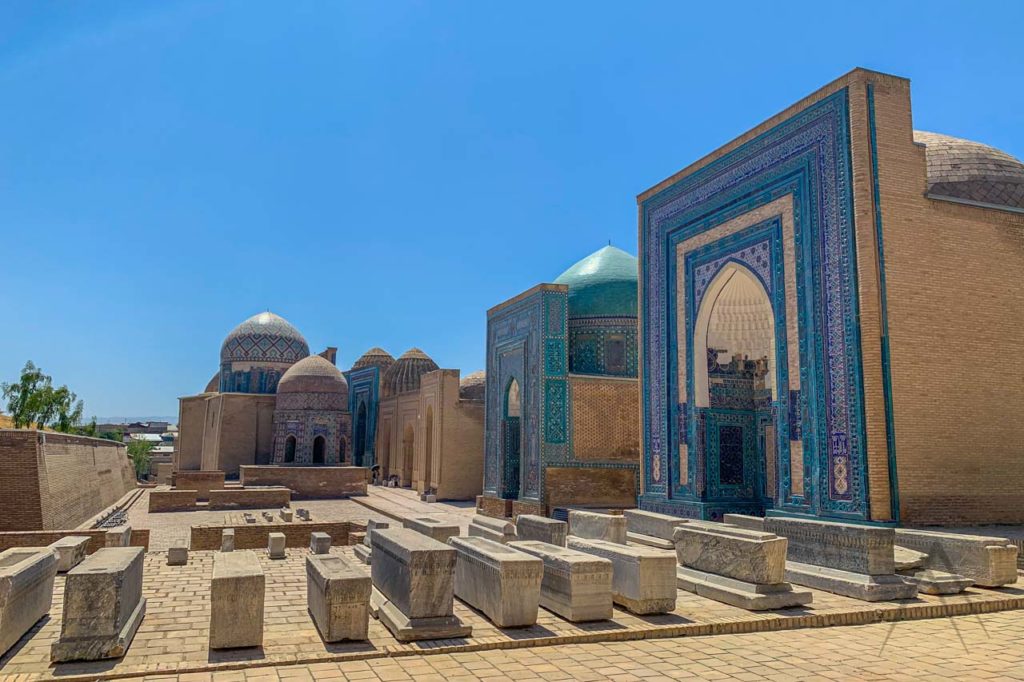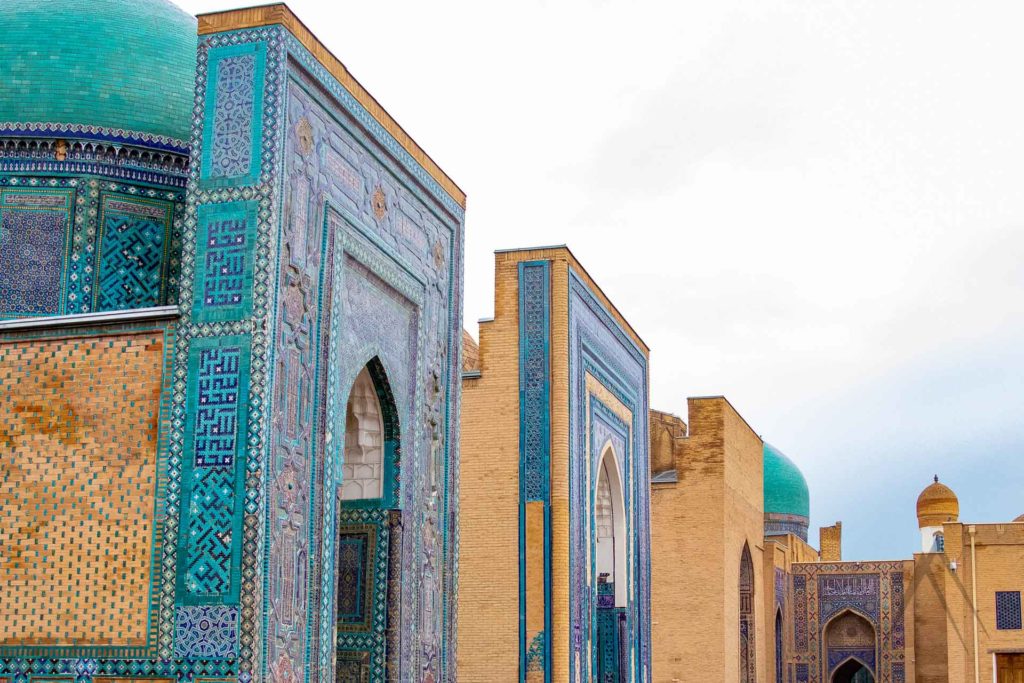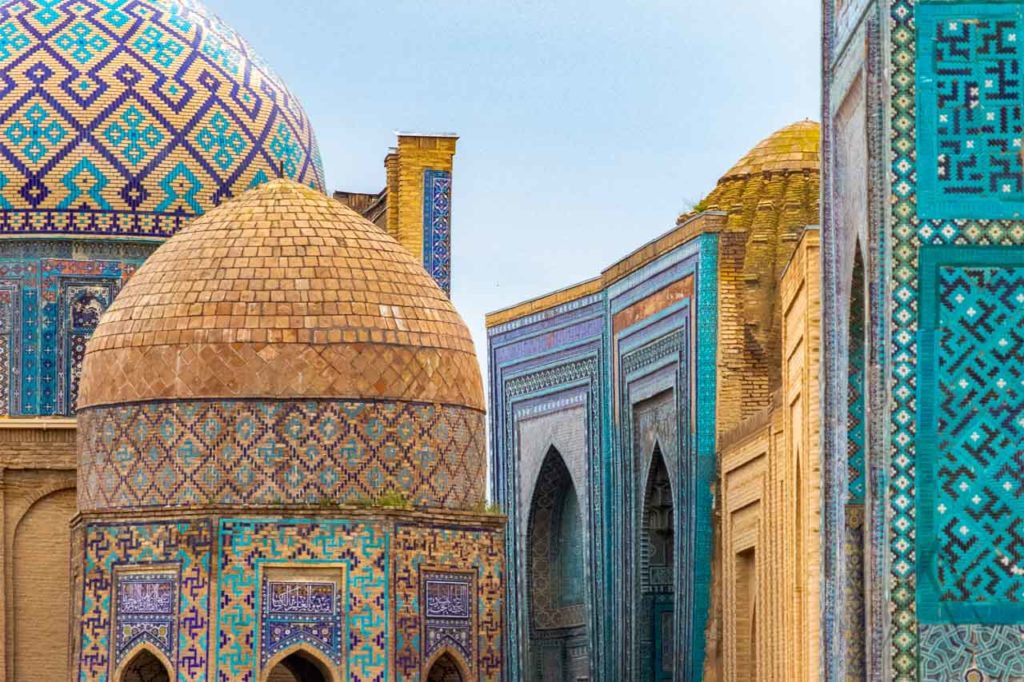SHAH I ZINDA
Shah-i-Zinda
Shah i Zinda (or Shakh i Zinda) is one of Samarkand’s most moving and visited sites with its stunning avenue of mausoleums that contain some of the richest tile work in the Muslim world. Shakh i Zinda reflects all the historical milestones in the development of the city and is a hugely popular religious monument where pilgrims come to pay their respect from all around the world and its mausoleums and tombs is included in the UNESCO list of cultural heritage. Shah i Zinda is the highlight of several of our Uzbekistan tours.
In the 14th and 15th centuries, it developed into an architectural testing ground and its celebration of ceramic art, unrivaled in Central Asia and it made this street of the dead perhaps the most visually stunning sight in a city of superlatives. It was first a Zoroastrian temple but it was destroyed and converted into a mosque soon after the Arab invasion.
Shah-i-Zinda history
The origin of the Shahi-Zinda necropolis at the hillside of Afrasiab settlement is related to Kusam ibn Abbas and is considered being his grave. Kusam ibn Abbas is a cousin of the Prophet Mohammed who is said to have brought Islam to this area in the 7th century. Legend follows his history back to year 676 when Kussam-ibn-Abbas arrived to convert Zoroastrian Sogdiana to Islam.
The success of his preaching provoked a gang of fire-worshippers to behead him whilst he was at prayer. It appears the Arabs might have established Kussam, who probably never saw Samarkand, to replace the cult of Shahi-Zinda (The Living King) by changing this pre-Islamic mythical ruler, maybe Afrosiab himself, into something ruling beyond death beneath the earth. A memorial to Kusam existed here on the edge of Afrosiab long before the Mongols explored it in the 13th century.
Shah-i-Zinda got its current form in the 14th century as Timur and later Ulugbek buried their family and favorites near the Living King. Excavations at the mausoleum of Kusam ibn Abbas have revealed there is a body inside (that of a middle-aged man), but his exact identity is unknown.
The Timurid aristocracy continued the tradition of building mausoleums near the sacred site, often on earlier remains. These works represent the original wealth of the empire in remarkable harmony. Their modest size permits an intimacy impossible in more grandiose projects.
The earliest tombs are those at the north of the site, which dates from the second quarter of the 14th century when the site was revived following the city’s sacking by the Mongols. The blue tombs are part of the necropolis built for Timur’s female relatives. These mausoleums also feature painted majolica tiles.

Worshippers used to gather to the necropolis until Soviet Union converted it into an anti-religious museum and forced visitors to cloak their beliefs with secular trappings. After the Independence of Uzbekistan, the complex has restored sanctity to the street, holy men to its mosques and pilgrims to its tombs. The present mosque dates from 1854 and has very finely painted ceilings and plasterwork.


Shah i Zinda Tombs & mausoleums
The most attractive tombs in Shah i Zinda are those of Timur’s niece, Shadi Mulk Oko (1372) and his sister, Shirin Bek Ata (1386), the decoration of which includes a quote from Socrates. This tomb is located second on the left after the entry stairs. The exquisite majolica and terracotta work here – notice the minuscule amount of space between the tiles – was of such exceptional quality that it merited almost no restoration.
The central group of tombs date from the 1380s and 1390s and are built atop an earlier (11th century) madrassa. Look out for the 16-sided tomb of Amir Burunduk, the slightly later octagonal mausoleum built by Ulug Beg, and the glorious Alim Nesefi Mausoleum with its relief majolica tiles, eight-pointed stars and the inscribed names of the 12 Shi’ite imams. The latest group of tombs are to the south of the site. These were built at the time of Ulug Beg and include the tomb of Timur’s nurse.
Excavations have shown there was also a medieval bathhouse here. The summer mosque and small madrassa on both sides of the entrance gateway are from the 19th century being relatively recent additions compared to the other buildings of the site.

